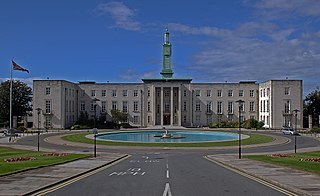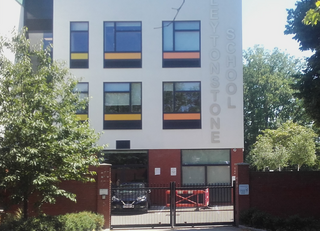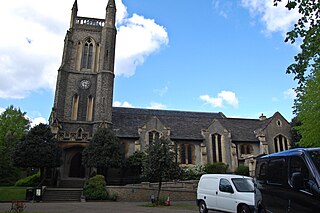
Chingford is a district in North East London, located in the London Borough of Waltham Forest and is situated 10 miles (16 km) northeast of Charing Cross. Historically a rural Essex parish, it gained urban district status in 1894, and between 1938 and 1965 formed the core of the Municipal Borough of Chingford. Chingford is close to the Essex border of Epping Forest District. Chingford has a population of 66,211 as of 2011, represented by six electoral wards, which includes its sub-neighbourhoods such as Chingford Mount, Friday Hill and Highams Park.

Leyton is a district of east London and part of the London Borough of Waltham Forest, located 6.2 miles (10 km) north-east of Charing Cross in the United Kingdom. It borders Walthamstow and Leytonstone in Waltham Forest, Stratford in the London Borough of Newham and Homerton and Lower Clapton in the London Borough of Hackney. The district includes part of the Queen Elizabeth Olympic Park, which hosted the 2012 Olympic Games, as well as Leyton Orient Football Club, although it is predominantly residential. It consists mainly of terraced houses built between 1870 and 1910, interspersed with some modern housing estates.

Walthamstow is a major district in North East London, the central settlement of the London Borough of Waltham Forest. It is located 7.5 miles (12.1 km) north-east of Charing Cross. Historically in the county of Essex, it significantly increased in population as part of the suburban growth of London and was incorporated as the Municipal Borough of Walthamstow in 1929 before becoming part of Greater London in 1965. Walthamstow is situated between the North Circular Road to the north, the Lea Valley and Walthamstow Reservoirs to the west, and Epping Forest to the east.

The London Borough of Waltham Forest is a London borough in northeast London, England.

Leytonstone is an area of East London, and part of the London Borough of Waltham Forest. It is a suburban area, located seven miles north-east of Charing Cross in Greater London. It borders Walthamstow to the north-west, Wanstead to the east, Stratford and Leyton to the south west and west respectively, and Forest Gate to the south. The area is served by Leytonstone tube station on the Central line & Leytonstone High Road on London Overground's Gospel Oak to Barking line. The northern end of Leytonstone High Road, beside Wanstead Flats, is known as Bushwood.

Leyton is a London Underground station in Leyton, in London, England. Located on Leyton High Road, adjacent to the A12, the station is on the Central line between Stratford and Leytonstone. It is in zone 3.

Leyton and Wanstead is a constituency created in 1997 represented in the House of Commons of the UK Parliament since 2010 by John Cryer of the Labour Party.

Leyton was a local government district in southwest Essex, England, from 1873 to 1965. It included the neighbourhoods of Leyton, Leytonstone and Cann Hall. It was suburban to London, forming part of the London postal district and Metropolitan Police District. It now forms the southernmost part of the London Borough of Waltham Forest in Greater London.

Walthamstow was a local government district in southwest Essex, England from 1873 to 1965, around the town of Walthamstow. It was within the London suburbs, forming part of the London postal district and Metropolitan Police District. Its former area now corresponds to the central part of the London Borough of Waltham Forest in Greater London.

Whipps Cross University Hospital is a large university hospital in the locality of Whipps Cross in Leytonstone and is within Epping Forest in the London Borough of Waltham Forest, London, England. It is managed by Barts Health NHS Trust.

Whipps Cross is an area of the London Borough of Waltham Forest in London, England. It is most famous for Whipps Cross University Hospital.

Waltham Forest London Borough Council is the local authority for the London Borough of Waltham Forest in London, England which has existed since the London Government Act 1963 was commenced in 1965, replacing three local authorities: Chingford Borough Council, Leyton Borough Council and Walthamstow Borough Council. It is one of London's 32 borough councils, divided into 20 wards and elects 60 councillors.

Leytonstone School is a mixed, comprehensive 11-16 school on Colworth Road in Leytonstone, London.

The 491 Gallery was a squatted self-managed social centre and multi-disciplinary gallery in Leytonstone, London, England, that operated from 2001 to 2013. Taking its name from its street number, 491 Grove Green Road, the former factory was home to a community-led art organisation and served as an exhibition space for a diverse range of artists of different origins working in varied media. It contained a range of art and music studios, which were used to host workshops, classes and musical rehearsals. The building was subsequently demolished in 2016.

Waltham Forest Town Hall is a municipal building located in Walthamstow, East London. It is a Grade II Listed Building.

St. John The Baptist's is a church in the centre of Leytonstone, at the junction of the High Road and Church Lane. St. John's is part of the Church of England, the Diocese of Chelmsford and the Deanery of Waltham Forest.

West Ham Union Workhouse was a workhouse in Leyton, built in the village of Holloway Down between 1839 and 1841 and run by the West Ham Poor Law Union. That Union covered several parishes in what is now Newham, Redbridge and Waltham Forest. West Ham Borough Council took over its running in 1930 and renamed it the Central Home Public Assistance Institution, using it as a home for the infirm, aged and chronically sick. In 1948 it formally became a National Health Service hospital under the name of the Langthorne Hospital, which remained open until 1999.

The Green Man is a pub and road junction on High Road, Leytonstone, London. The pub has been rebranded as part of the O'Neill's chain. The current 1920s building replaced an earlier public house on the same site, built around 1668; it was mentioned by Daniel Defoe.

The Church of St Andrew, Leytonstone is a Victorian era Church of England parish church in Leytonstone, East London, adjacent to Epping Forest. It is a Grade II listed building.
























